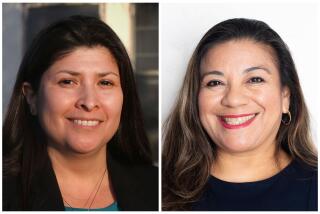School management 101
- Share via
THIS WEEK, Mayor Antonio Villaraigosa will reveal his strategy to take control of the Los Angeles Unified School District. He has said he wants to end the finger-pointing between city officials and elected school board members over the district’s failing record by joining other big city mayors who have taken over the schools to improve student performance.
One thing should be clear. Mayoral control is not about whether L.A.’s top city official can spur students to do better on achievement tests. Rather, it is a political answer to the question of who should make school policy. This is an essential distinction that few reformers say publicly. There is nothing illegal, unethical or inefficient about altering who controls school districts. It is, however, misleading, if not dishonest, to advertise that mayoral control will directly help students improve their academic performance.
Mayoral control over schools is the latest example of top-down school reform. In Chicago, Boston, Cleveland and New York City, elected school boards were dumped. The mayors appointed board members and superintendents, and charged them with shaking up teachers and principals to raise students’ test scores. If the schools continue to fail, voters will know whom to blame -- the mayor -- and can hold him accountable at the polls. This is the magical thinking behind the idea of mayoral control.
The results of the takeovers are mixed, at best. Thomas M. Menino of Boston and Michael R. Bloomberg of New York City are promoted as shining examples of mayors who have turned around academically low-performing schools, but their critics see a more uneven picture.
From 1987 to 1999, Baltimore Mayor Kurt Schmoke appointed school board members and played a major role in hiring and firing superintendents. His reform agenda even included a contract with a private corporation to run certain Baltimore schools. But during (and after) his tenure, most Baltimore schools continued to score so low on state tests that they were placed on probation.
Mayor Richard M. Daley’s decade-long foray into raising academic achievement in Chicago’s schools has led to some improvements in elementary school test scores. But high numbers of dropouts and low graduation rates continue to plague high schools. Still, no advocates for school reform have called for a return to an elected school board in Chicago.
Superintendent-mandated change -- another favorite top-down reform approach -- has produced similar results to mayoral takeovers. In San Diego, for instance, then-Supt. Alan D. Bersin reorganized the district’s central office, instituted a “blueprint for success” for every school to follow, and pressed teachers and principals to concentrate on instruction.
And then-Supt. Gerry House of Memphis City Schools required every principal and faculty member in her district to pick a school reform to improve students’ achievement and then implement it. In both San Diego and Memphis, elementary school test scores improved, while high school scores did not keep pace with the improvements at the lower grades.
How can Villaraigosa improve on this uneven record of top-down school reform?
First, get a grip on the basic problem. Villaraigosa blames the elected school board and an inefficient district bureaucracy for students’ poor test scores. Yet the single most important in-school factor that directly influences academic achievement is neither the school board nor a central office bureaucrat. Rather, it is the experience, subject-matter expertise, leadership and knowledge of children that a teacher brings to a classroom, as well as the personal ties that evolve between students and teacher over time.
But as with their counterparts in the school takeovers by other big city mayors, L.A.’s teachers will probably not be willing allies of the mayor’s plan. Their union has opposed mayoral control and reportedly will offer its own ideas about improving student performance before Villaraigosa’s speech.
Fierce union resistance to a takeover, as occurred in a few of the big cities, will certainly make it harder for Villaraigosa to realize his ambition. But the mayor has reconciled seemingly irreconcilable interests before, and one way to win over teachers is to support their growth as professionals and to provide remedial training when needed. Still, to help boost students’ academic achievement, he and his appointees must concentrate on improving the quality of personnel they recruit, train and put in classrooms.
That chance increases if Villaraigosa understands that the principal’s expertise is also critically important in improving student achievement. Study after study has revealed that the principal is key to pushing and supporting teachers by establishing a demanding climate in school so students can concentrate on academic achievement.
Second, have a short agenda for a long time. Because schools are viewed as central to a city’s economic and social vitality, city leaders and educators desperate over continuing low test scores in the district have created a long list of reforms. What’s needed instead is a short and realistic list of key school reforms, agreeable to community leaders and educators, aimed at improving teaching and learning. With that list in hand, Villaraigosa can mobilize and deploy city and private resources to carry out the reform agenda for at least a decade.
For supporters of mayoral control, the major lesson to learn is that there is nothing magical about who decides school policy. If anything, too much hullabaloo over a mayoral takeover can divert attention from the hard work that occurs in classrooms between teachers and students.
More to Read
Sign up for Essential California
The most important California stories and recommendations in your inbox every morning.
You may occasionally receive promotional content from the Los Angeles Times.










